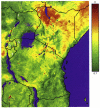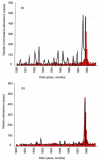Forecasting disease risk for increased epidemic preparedness in public health
- PMID: 10997211
- PMCID: PMC3196833
- DOI: 10.1016/s0065-308x(00)47013-2
Forecasting disease risk for increased epidemic preparedness in public health
Abstract
Emerging infectious diseases pose a growing threat to human populations. Many of the world's epidemic diseases (particularly those transmitted by intermediate hosts) are known to be highly sensitive to long-term changes in climate and short-term fluctuations in the weather. The application of environmental data to the study of disease offers the capability to demonstrate vector-environment relationships and potentially forecast the risk of disease outbreaks or epidemics. Accurate disease forecasting models would markedly improve epidemic prevention and control capabilities. This chapter examines the potential for epidemic forecasting and discusses the issues associated with the development of global networks for surveillance and prediction. Existing global systems for epidemic preparedness focus on disease surveillance using either expert knowledge or statistical modelling of disease activity and thresholds to identify times and areas of risk. Predictive health information systems would use monitored environmental variables, linked to a disease system, to be observed and provide prior information of outbreaks. The components and varieties of forecasting systems are discussed with selected examples, along with issues relating to further development.
Figures





References
-
- Baylis M, Mellor PS, Meiswinkel R. Horse sickness and ENSO in South Africa. Nature. 1999;397:574. - PubMed
-
- Berkelman RL. Emerging infectious diseases in the United States. Annals of the New York Academy of Science. 1994;740:346–361. - PubMed
-
- Berkelman RL. The public health response to emerging infectious diseases: are current approaches adequate? In: Greenwood B, De Cock K, editors. New And Resurgent Infections: Prediction, Detection and Management of Tomorrow’s Epidemics. John Wiley; London: 1998.
-
- Bouma MJ, Poveda G, Rojas W, et al. Predicting high risk years for malaria in Colombia using parameters of El Niño Southern Oscillation. Tropical Medicine and International Health. 1997;2:1122–1127. - PubMed
Publication types
MeSH terms
Grants and funding
LinkOut - more resources
Full Text Sources
Medical
